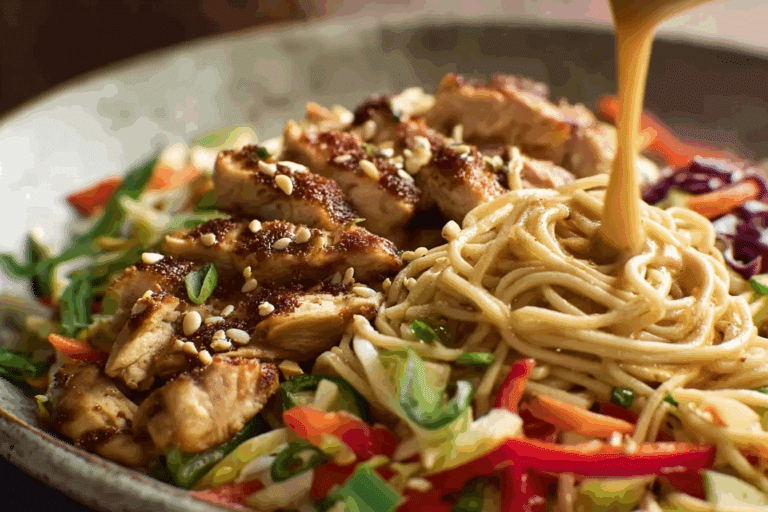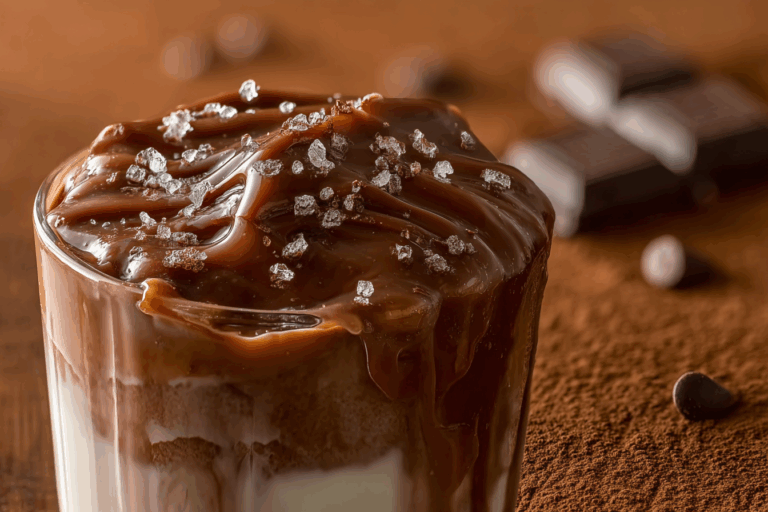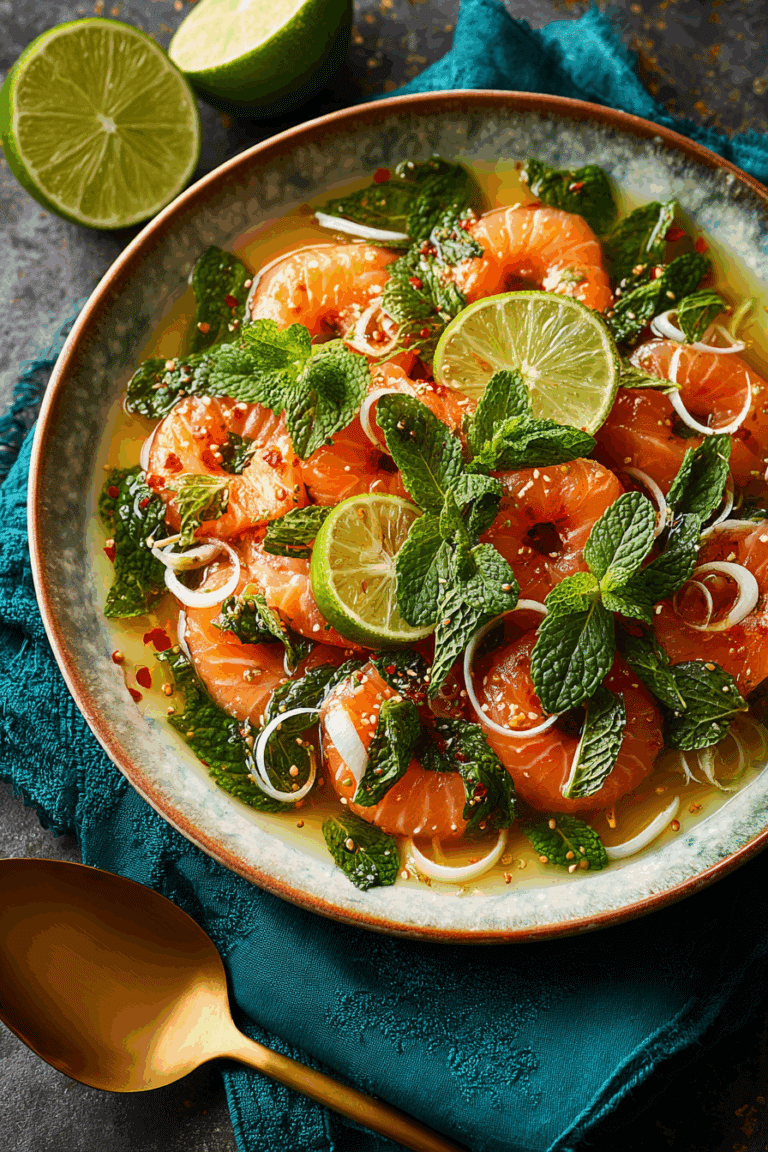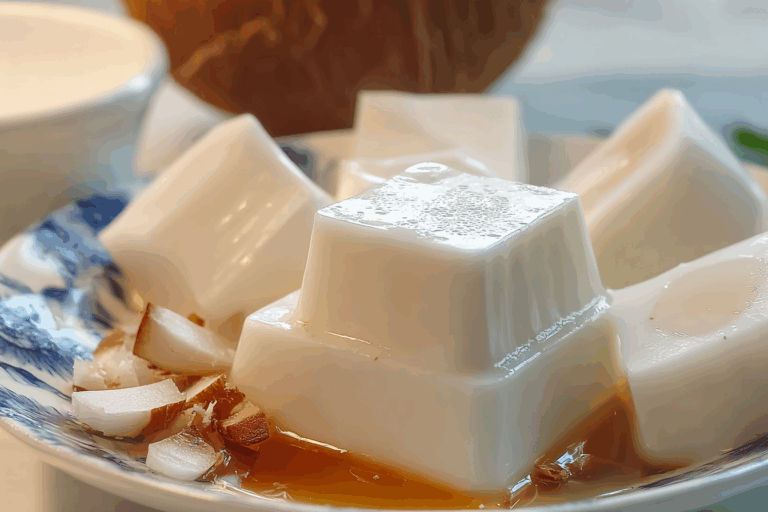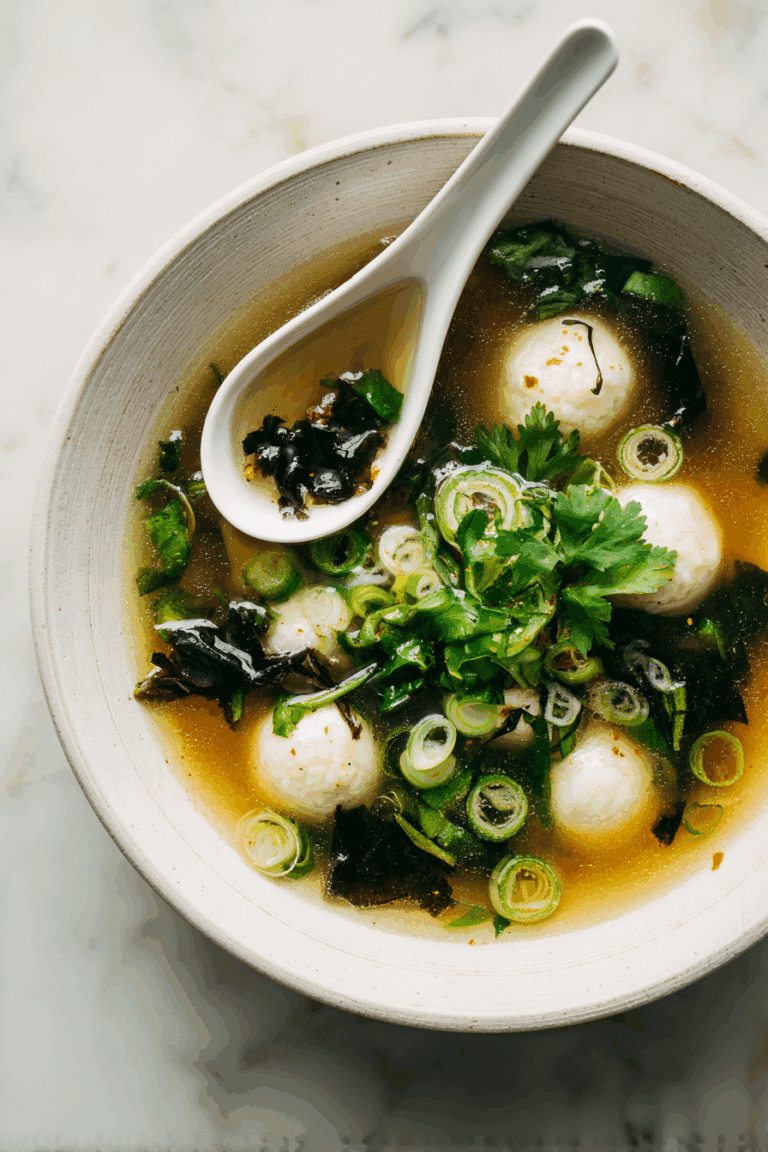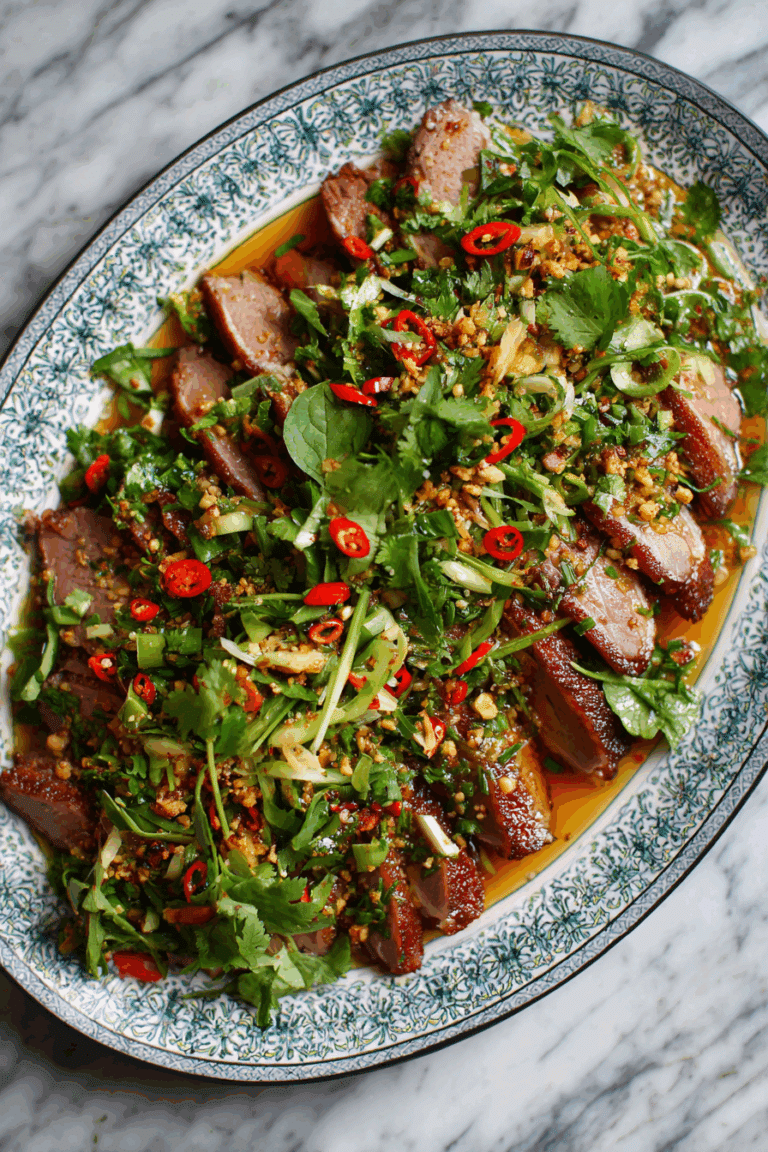Lamb Shanks Massaman Curry: An Easy, Authentic Curry to Master
Lamb Shanks Massaman Curry has always been one of those dishes that makes me feel at home no matter where I am. When I first started Just Thai Recipes, my goal was to share not just the flavors of Thai cuisine but also the personal stories behind each recipe. If you have ever visited the About page on my site, you already know that this project started from my family’s dinner table.
I grew up watching my mother and grandmother cooking curries that filled the entire house with aromas of cinnamon, coconut, and star anise. Over the years, I wanted to keep those memories alive and share them with food lovers around the world. This Lamb Shanks Massaman Curry is one of those recipes that brings together tradition, comfort, and the joy of slow cooking.
In this article, you will not only learn how to make a restaurant-quality Lamb Shanks Massaman Curry at home but also explore variations like the Lamb Shanks Massaman Curry Jamie Oliver version, tips for a Slow Cooker Lamb Shank Massaman Curry, and why many people consider the Lamb Massaman Curry BBC Good Food style one of the best. By the end, you will know how to prepare the dish step by step, avoid common mistakes, and understand its cultural significance in Thai cuisine.
Table of Contents
Table of Contents
Ingredients for Lamb Shanks Massaman Curry
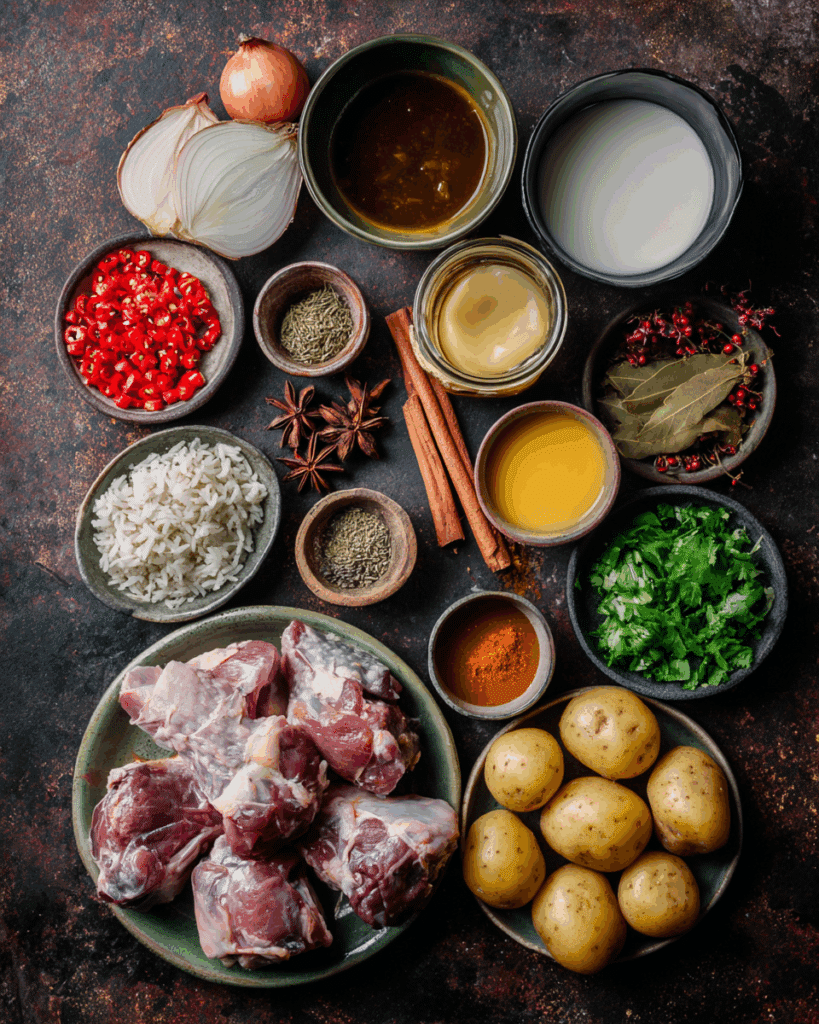
When preparing Lamb Shanks Massaman Curry, the ingredients are as important as the method. This curry is rich, aromatic, and deeply flavorful thanks to the slow cooking of tender lamb shanks in coconut milk and spices. Here is a detailed list of everything you will need, along with some helpful notes.
Main Ingredients
- 1.5 kg / 3 lb lamb shanks (about 5 small, 4 medium, or 2–3 large shanks)
- 114 g / 4 oz Maesri Massaman curry paste (1 can, or substitute with another good brand if unavailable)
- 400 ml / 14 oz full-fat coconut milk (Ayam brand is preferred for creaminess)
- 2 cups chicken stock or broth, low sodium
- 1 onion, halved and sliced about 1 cm thick (yellow, white, or brown)
- 400 g / 14 oz small potatoes (about 2.5 cm wide, halved if bigger)
- 1 whole star anise
- 1 cinnamon stick
For Garnishing
- Fresh red chili, finely sliced (choose small chili for more heat, or large for mild spice)
- Fresh coriander or cilantro leaves
- Steamed jasmine rice for serving
Cook Mode
If you are cooking while reading this online, you might want to enable cook mode to prevent your screen from going dark during the process.
Step-by-Step Instructions
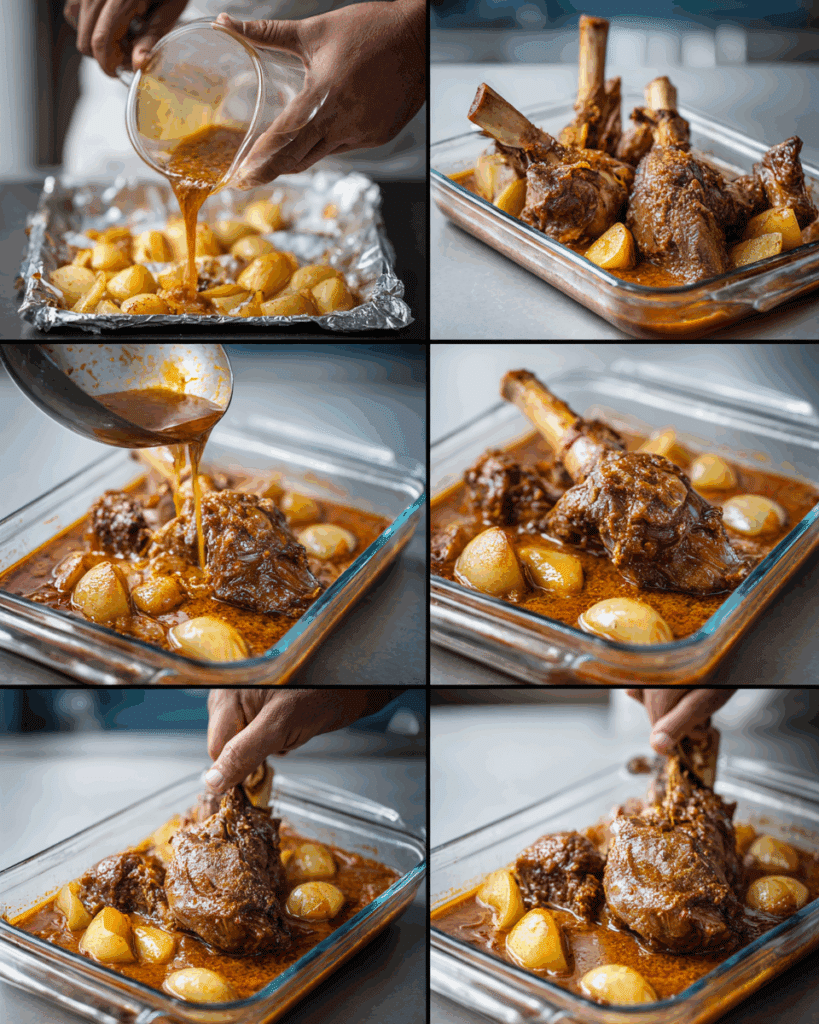
Cooking Lamb Shanks Massaman Curry is not difficult, but it does require patience. The long, slow cooking time transforms the lamb into melt-in-your-mouth tenderness, while the curry develops layers of flavor.
- Preheat your oven to 180°C / 350°F (160°C fan).
- In a 22 x 33 cm or 9 x 13 inch baking dish, preferably glass or ceramic, mix together the Massaman curry paste, coconut milk, and chicken stock until combined.
- Add the sliced onion, potatoes, star anise, cinnamon stick, and lamb shanks. Turn the lamb shanks in the sauce so they are well coated.
- Cover the dish tightly with foil and bake for 2 hours.
- After 2 hours, remove the foil and bake uncovered for another 1 to 1.5 hours depending on the size of your lamb shanks. Turn the shanks twice during cooking to ensure even browning.
- Once the lamb is fork-tender, remove it onto a plate. Skim excess fat from the surface of the sauce. This step is important because Massaman curry cooked with lamb tends to be rich, and removing some of the fat keeps the sauce balanced.
- Stir the sauce in the baking dish until it has reduced to a glossy, syrupy consistency.
- Serve the lamb shanks over jasmine rice, spooning the curry sauce generously over the top. Garnish with sliced chili and fresh coriander.
This is the classic way of preparing Lamb Shanks Massaman Curry in the oven. However, many people also experiment with stovetop or slow cooker methods, which we will discuss later.
For another perspective, check out external recipes like Recipe Tin Eats Lamb Shanks Massaman Curry or Chef Not Required Massaman Curry Lamb Shanks. These resources show how versatile the dish can be while keeping it authentically Thai in flavor.
Tips and Tricks for the Best Lamb Shanks Massaman Curry
Getting the most out of your Lamb Shanks Massaman Curry depends on a few small but impactful tips.
- Choose the right lamb shanks: Medium-sized shanks cook evenly and absorb flavor better. Very large shanks may need extra cooking time.
- Do not skip skimming fat: This is one of the biggest mistakes people make with lamb curries. The dish should be rich but not greasy.
- Curry paste choice matters: Maesri is authentic and gives the best balance, but if unavailable, use another Thai brand rather than a generic curry paste.
- Slow cooking equals tenderness: Rushing the cooking process will give you tough lamb. Trust the timing.
- Use full-fat coconut milk: Light coconut milk will not give the creamy consistency this dish deserves.
Another helpful trick is to prepare the curry a day in advance. Like most stews and braises, Lamb Shanks Massaman Curry tastes even better the next day once the flavors have settled together.
Variations of Lamb Shanks Massaman Curry
There are so many ways to adapt this recipe depending on what you have at home and how you like your curry. Here are some delicious twists:
- Lamb Shanks Massaman Curry Jamie Oliver Style
This version often includes a few extra spices like cloves and cardamom pods, giving the curry a deeper aroma. - Slow Cooker Lamb Shank Massaman Curry
If you prefer a hands-off method, place all ingredients in a slow cooker and cook on low for 8 hours or on high for 5 hours. This results in fall-off-the-bone meat without using the oven. - Lamb Massaman Curry BBC Good Food Inspired
BBC Good Food often emphasizes family-friendly recipes, so this variation uses milder curry paste and slightly more coconut milk to balance the spice. - Best Lamb Shank Curry Recipe for Entertaining
To impress guests, you can add roasted peanuts and a squeeze of lime juice just before serving for extra brightness. - Authentic Lamb Massaman Curry Recipe
For purists, stick with the classic recipe using Maesri paste, whole spices, and no shortcuts. This keeps it close to traditional Thai roots.
Nutrition and Health Benefits
Lamb Shanks Massaman Curry is indulgent, comforting, and loaded with real nourishment when you build your plate with balance in mind. A generous bowl of Lamb Shanks Massaman Curry gives you slow cooked protein, complex carbohydrates, and aromatic spices that support flavor and satisfaction. When people ask me if Lamb Shanks Massaman Curry can fit into a wholesome lifestyle, my answer is yes, and here is exactly how to make that happen in your own kitchen.
Estimated calories and macros per serving
For a typical home serving, which is one medium lamb shank with a ladle of sauce and a small scoop of jasmine rice, Lamb Shanks Massaman Curry lands around 600 to 700 calories. If you skim the fat after braising, which I recommend, you can slide closer to 600. On average, Lamb Shanks Massaman Curry provides about 35 to 45 grams of protein, roughly 25 to 35 grams of carbohydrates before rice, and about 30 to 40 grams of fat depending on how much coconut cream separates in your can and how much surface fat you remove from the pan.
When you add a side of steamed greens or a crunchy cucumber salad, Lamb Shanks Massaman Curry becomes a well rounded, satisfying meal that actually keeps you full longer, which can support mindful portions across the day.
Protein, iron, and B vitamins from lamb
Lamb carries an impressive protein profile that supports muscle repair and daily energy. With Lamb Shanks Massaman Curry you get complete proteins plus iron and vitamin B12. Iron helps oxygen move through your body and B12 supports the nervous system, so Lamb Shanks Massaman Curry is a smart option for anyone who wants dinner that tastes luxurious while still delivering nutrients. If you have athletes at home or teenagers who are always hungry, Lamb Shanks Massaman Curry makes an easy win because a single shank satisfies without needing a long list of sides.
Fats from coconut milk, how to keep balance
The creamy body of Lamb Shanks Massaman Curry comes from full fat coconut milk, which contains saturated fats along with medium chain triglycerides. This is part of what makes Lamb Shanks Massaman Curry feel so velvety and rich. If you want a lighter bowl, chill the curry for twenty minutes after cooking, skim off the top layer of solid fat, then rewarm gently. You still get the classic taste of Lamb Shanks Massaman Curry, just a lighter mouthfeel. You can also swap half of the coconut milk with low sodium chicken stock. This keeps the spice harmony intact while trimming overall calories.
Potatoes and onions, gentle carbs with comfort
Potatoes and onions do more than bulk out the stew. They provide potassium, fiber, and slow release carbohydrates that make Lamb Shanks Massaman Curry deeply comforting. If you are watching carbs, portion your rice modestly, then let the potatoes inside the Lamb Shanks Massaman Curry carry more of the load. Another trick is to serve Lamb Shanks Massaman Curry over steamed cauliflower rice, which gives you a similar fluffy base with fewer carbs and a pleasant sweetness that plays nicely with cinnamon and star anise.
Spice cupboard benefits, small ingredients with big roles
Massaman’s spices have a reputation for warmth and calm. In Lamb Shanks Massaman Curry, whole star anise and cinnamon sticks infuse the sauce with gentle aromatics. While spices are not a medical treatment, they are naturally rich in antioxidant compounds. This means your Lamb Shanks Massaman Curry brings a little bonus beyond taste. Fresh coriander and red chili at the end add vitamin C and a bit of capsaicin, which can feel energizing. The combined effect is that Lamb Shanks Massaman Curry feels restorative, almost like a cozy blanket in a bowl.
Sodium and seasoning, how to dial it in
Commercial curry pastes can vary in saltiness. If you use a low sodium broth and taste as you go, Lamb Shanks Massaman Curry stays balanced. Skim the fat, then adjust with a squeeze of lime or a splash of water if salt feels concentrated after reduction. Once you learn the rhythm of your favorite brand, Lamb Shanks Massaman Curry becomes second nature, reliably seasoned every time.
Dietary swaps that still feel authentic
If you cook for mixed diets, Lamb Shanks Massaman Curry adapts beautifully. For dairy free households, you are already covered since the creaminess comes from coconut milk, not dairy. If someone is nut sensitive, skip roasted peanuts and keep the focus on the tender meat and potatoes. To build fiber, stir in cubes of carrot or chunks of pumpkin during the last hour of braising. These additions make Lamb Shanks Massaman Curry even more nourishing without losing that signature taste.
Portioning ideas for everyday eating
I like the balanced plate method. Fill half your plate with non starchy vegetables, a quarter with jasmine rice or cauliflower rice, and a quarter with Lamb Shanks Massaman Curry. This approach keeps Lamb Shanks Massaman Curry front and center while helping you feel energized, not sleepy, after dinner. If you are meal prepping, portion Lamb Shanks Massaman Curry with a measured cup of rice and a handful of steamed greens. It reheats like a dream and tastes even deeper the next day.
Bottom line on wellness
When you reduce surface fat, choose a modest scoop of rice, and build a plate with colorful vegetables, Lamb Shanks Massaman Curry slides easily into a balanced lifestyle. The hearty protein and fragrant spices make Lamb Shanks Massaman Curry a dinner that satisfies craving and nutrition at the same time. If a recipe can be both feel good and good for you, Lamb Shanks Massaman Curry is it.
Make Ahead, Storage, and Freezing
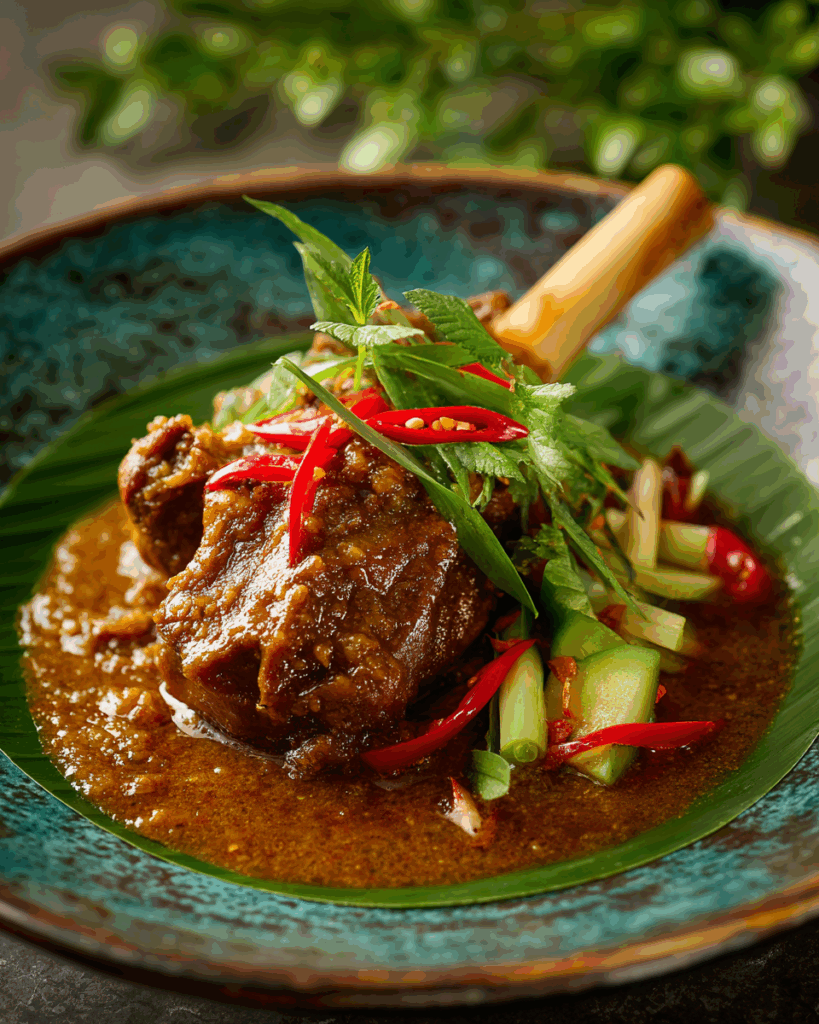
Lamb Shanks Massaman Curry rewards planners. The flavors settle and round out with time, so your leftovers can taste even better than day one. Here is a simple strategy so Lamb Shanks Massaman Curry stays silky, safe, and delicious from fridge to freezer.
Make ahead timeline
Day 1, braise the lamb, skim the fat, then cool the baking dish on a rack for 20 to 30 minutes. Transfer Lamb Shanks Massaman Curry to shallow containers so it chills quickly and evenly. This prevents overcooking the potatoes and keeps the sauce glossy. If you plan to serve guests tomorrow, Lamb Shanks Massaman Curry will be at peak flavor on Day 2. Rewarm slowly on low heat, covered, which protects the sauce from splitting.
Safe storage, practical containers
Use airtight containers with tight fitting lids. Ladle Lamb Shanks Massaman Curry shanks and sauce together, one shank per container for simple portions, or store shanks in one container and sauce in another for more control. Refrigerate within two hours. In the fridge, Lamb Shanks Massaman Curry holds well for up to four days. Label with the date so there is no second guessing later.
Reheating without losing silkiness
For the stovetop, place Lamb Shanks Massaman Curry in a heavy pot with a splash of water or stock. Cover and heat on low, stirring the sauce every few minutes until hot. For the oven, arrange Lamb Shanks Massaman Curry in a baking dish, cover with foil, and warm at 160 Celsius or 325 Fahrenheit until steaming. For the microwave, reheat Lamb Shanks Massaman Curry in short bursts, stirring the sauce between bursts so the coconut base stays smooth.
If the sauce thickens too much after chilling, loosen Lamb Shanks Massaman Curry with a few tablespoons of warm water or stock, then simmer for a minute. If it becomes too thin, simmer uncovered for a couple of minutes until it coats the back of a spoon again.
Freezing for busy weeknights
Lamb Shanks Massaman Curry freezes beautifully. Cool completely, then tuck each shank with a good scoop of sauce into freezer bags or rigid containers. Press out extra air if using bags. Freeze flat for quick thawing. Lamb Shanks Massaman Curry keeps for three months in the freezer. To thaw, move a portion from freezer to fridge the night before, then reheat gently. If you forgot to thaw, place the sealed bag in a bowl of cool water for 30 to 40 minutes, then warm it on the stove. The flavors hold up, and the texture of Lamb Shanks Massaman Curry remains luscious.
Potatoes in the freezer, a small note
Potatoes can soften after freezing. If you know you will freeze, cook the potatoes a touch firmer on day one. They will finish softening when you reheat Lamb Shanks Massaman Curry later. Another option is to pull the potatoes from the curry before freezing, then add freshly simmered cubes when you reheat. Both approaches keep Lamb Shanks Massaman Curry tasting restaurant ready.
Batch cooking and menu planning
If you have a large family or love leftovers, double the recipe. Enjoy Lamb Shanks Massaman Curry on night one with jasmine rice, then turn leftovers into soft tacos with shredded lamb, cucumber ribbons, and a drizzle of reduced curry sauce. On another night, spoon Lamb Shanks Massaman Curry over roasted sweet potatoes or toss the sauce through thick noodles. A single weekend cook can set you up for several creative dinners, all anchored by Lamb Shanks Massaman Curry.
Common Mistakes to Avoid
Even confident cooks can trip over a few details. Here are the mistakes I see most often and exactly how to fix them so your Lamb Shanks Massaman Curry turns out tender, glossy, and deeply flavored every time.
Not salting and tasting as you go
Curry paste and stock bring salt, and every brand is different. If you never taste the sauce before the final hour, Lamb Shanks Massaman Curry might end up either flat or overly salty. Stir and taste at the midpoint, then again near the end. Adjust with a splash of water or a squeeze of lime if the seasoning feels sharp. This habit keeps Lamb Shanks Massaman Curry balanced.
Using light coconut milk
Light coconut milk tends to split and lacks body. It can make Lamb Shanks Massaman Curry watery. Use full fat coconut milk and skim surface fat later. You keep the creamy structure that lets Lamb Shanks Massaman Curry cling to the shanks and coat the rice.
Crowding the pan or dish
If shanks are packed tight with no breathing room, heat circulation suffers. The lamb steams instead of braising, and Lamb Shanks Massaman Curry can taste muted. Use a dish that fits the shanks in a single layer. Liquid should partially cover the meat so Lamb Shanks Massaman Curry braises evenly and reduces gradually.
Skipping the foil for the first cook
Foil seals in moisture during the first stage. If you skip it, the shanks dry and the sauce reduces before the collagen has time to melt. That means Lamb Shanks Massaman Curry may turn stringy. Keep the foil for the first two hours, then remove it to brown the shanks and thicken the sauce.
Not turning the shanks
If you never turn, one side of each shank stays pale. Turn the meat twice during the uncovered stage so Lamb Shanks Massaman Curry develops that appetizing, burnished color and even tenderness.
Overcooking potatoes
Small potatoes should be waxy and hold shape. If they cook too long, they collapse and muddy the sauce. Add them at the start for convenience, but choose firm small potatoes and cut larger ones in halves, not tiny pieces. This helps Lamb Shanks Massaman Curry keep a clean, silky sauce.
Forgetting to skim fat
Lamb naturally releases fat. If you forget to skim, Lamb Shanks Massaman Curry can feel heavy. Tilt the dish and spoon off fat carefully. The sauce will look glossy and taste clear, which lets the spices in Lamb Shanks Massaman Curry shine.
Using the wrong cut
Shanks are perfect because their connective tissue melts during low, slow heat. Lean steaks or chops will dry out. To keep the signature texture of Lamb Shanks Massaman Curry, stick with shanks or switch to shoulder cut into large chunks if shanks are unavailable.
Rushing the final reduction
The magic happens when the sauce reduces to a syrupy glaze. If you stop too soon, Lamb Shanks Massaman Curry will taste thin. If you reduce too hard, it might catch on the bottom. Keep the heat moderate, stir occasionally, and watch for the sauce to coat the spoon. That is Lamb Shanks Massaman Curry at its best.
Cultural and Historical Background
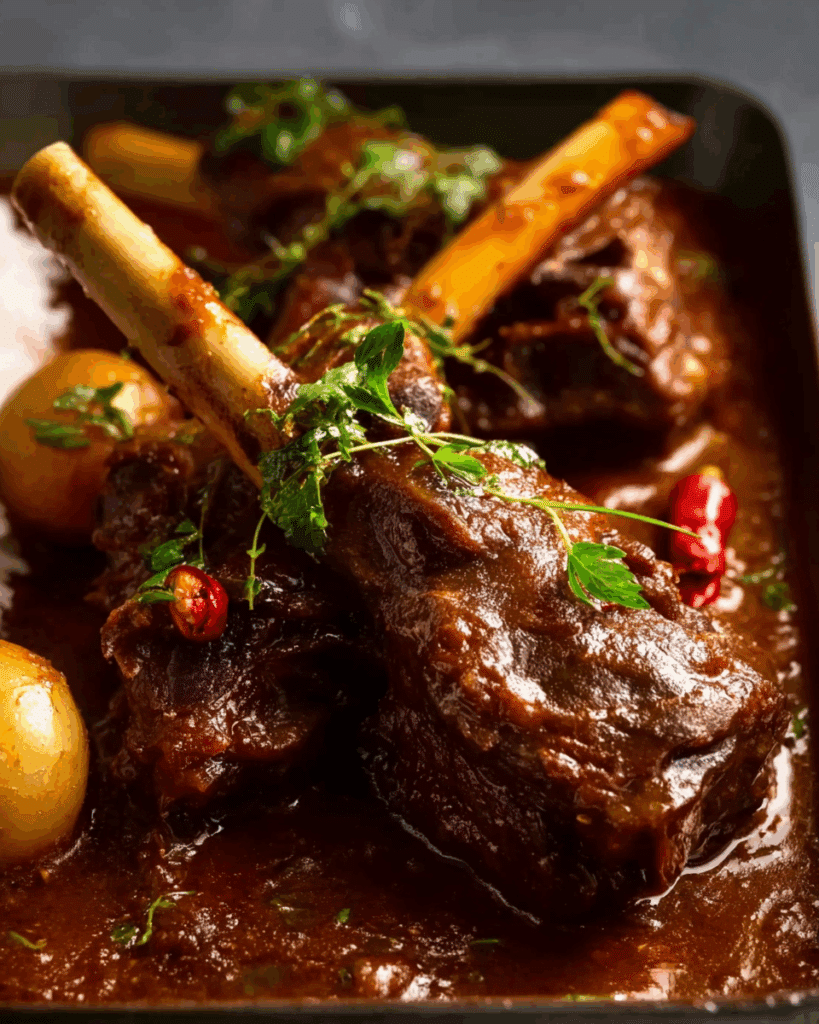
Massaman is often called a bridge curry, a bowl where trade winds, bustling ports, and home kitchens meet. Its story reaches back to the Malay Peninsula and the ancient spice routes that connected the Arabian Gulf, the Indian subcontinent, and southern Thailand. Merchants did not only carry cloves, cinnamon, and cardamom, they carried ideas, hospitality, and cooking methods. Over centuries, local cooks welcomed these imported aromatics into coconut based stews, layering them with Thai chiles, palm sugar, and fish sauce or salt, which created a gentle, warmly spiced style that feels both familiar and new at the same time.
The dish has special resonance in Muslim communities of southern Thailand, where beef and lamb are traditional celebration meats. Long, slow braises fit the rhythm of family gatherings and religious holidays, when large pots can simmer quietly while the rest of the meal is prepared. Bone in cuts are favored, because connective tissue melts into the sauce, lending a silky body you simply cannot fake with quick cooking methods. As Thai cuisine traveled the world, restaurants and home cooks embraced this curry as a friendly entry point, milder than green or red, with a rounded sweetness and perfume from cinnamon sticks and star anise.
Lamb itself carries a long history across West and South Asia, which makes its pairing with this spice profile feel natural. In households with roots in the Middle East, lamb stews scented with warm spices are already comfort food. When those families encountered Thai coconut curries, the match was easy. The result is a braise that honors Thai technique, embraces imported spices, and celebrates the tenderness of slow cooked lamb.
Another reason the curry thrived is adaptability. In coastal towns, cooks might add toasted peanuts for crunch. In some homes, a squeeze of tamarind adds brightness. In others, shallots and onions bring sweetness, while small waxy potatoes lend structure and familiar comfort. Across decades and countries, the core identity stayed the same, a soft, aromatic stew that welcomes guests and invites seconds.
Modern interpretations respect tradition while leaning into convenience. Pressure cookers shorten braise time, slow cookers free up the stove, and home ovens deliver steady heat without fuss. None of these updates erase the soul of the dish, which is patience, balance, and the knack for coaxing a humble cut into something worthy of a celebration table. That is the heart of massaman, a conversation between places, preserved in a pot.
Serving Suggestions
Thoughtful sides and finishing touches turn a single pot into a feast. Aim for balance, temperature contrast, and color. The curry itself is rich, creamy, and tender, so pair it with crisp, bright, and lightly acidic companions that lift each bite.
Rice, grains, and starchy bases
Jasmine rice is the classic base. Its floral aroma mirrors the spices, and its grains separate just enough to drink up the sauce without turning gummy. For added aroma, rinse the rice until the water runs nearly clear, soak for fifteen minutes, then steam. If you want a richer experience, cook coconut rice, which uses part coconut milk and part water with a small pinch of salt. The subtle sweetness echoes the stew without competing.
For a heartier, higher fiber base, choose brown jasmine rice, which adds a nutty chew. Quinoa works surprisingly well, its tiny curls catching the sauce. If you prefer a lighter plate, serve the braise over cauliflower rice or tender cabbage ribbons sautéed with a little garlic. The texture contrast keeps the meal bright, and you will still get every drop of the sauce.
Vegetables, salads, and pickles
Freshness makes the whole plate sing. A Thai style cucumber salad, dressed with rice vinegar, a pinch of sugar, and a sprinkle of salt, offers cool crunch between bites. Quick pickled red onions add acidity, which balances the coconut richness. Steamed or stir fried greens like baby bok choy, Chinese broccoli, or green beans bring color and a gentle bitterness that keeps the meal lively.
Roasted carrots glazed with a spoon of the curry sauce are another fun side, glossy, sweet, and fragrant. For a family style spread, set down bowls of sliced chilies in vinegar, chopped cilantro, lime wedges, and crushed roasted peanuts. Guests can build their own perfect bowl, adjusting heat and brightness to taste.
Breads and crispy textures
While rice is traditional, flatbreads have a place at the table too. Flaky roti or warm paratha gives you a handle for scooping sauce, which kids especially love. Crispy shallots sprinkled at the end add a delicate crunch, and thinly fried potato coins nod to the stew’s potato base while adding a playful garnish.
Drinks that complement, not compete
Pair this curry with beverages that cool the palate and highlight aromatics. Thai iced tea, lightly sweet and creamy, echoes the spices without overpowering. If you enjoy wine, look for a Riesling with a hint of residual sugar, a Gewürztraminer with floral notes, or a softly chilled rosé. Crisp lagers and rice beers are naturals, and for zero proof options, try sparkling water with lime, ginger tea over ice, or a pineapple mint cooler. All of these choices refresh the palate between rich, savory bites.
Plating and table style
For weeknights, serve straight from the pot over a bed of rice, a sprinkle of cilantro, and a few red chili slices. For gatherings, arrange the shanks on a warmed platter, spoon glossy sauce over the top, and nestle in small steamed potatoes and roasted shallots for drama. Scatter fresh herbs for color and bring the extra sauce to the table in a small jug. That small touch makes guests feel looked after.
Readers often explore connected topics when they fall in love with a dish. Instead of listing those searches as stark keywords, here is how to fold them naturally into your cooking plans and conversations.
You might be hunting for a reliable recipe for massaman made with lamb shanks, something that delivers consistent tenderness with pantry friendly steps. Others look for a Jamie Oliver inspired lamb shank massaman, which often leans into whole spices, fresh herbs, and a generous finish of lime for brightness. Busy home cooks gravitate toward a slow cooker lamb shank massaman, where everything tucks into the pot in the morning and dinner is ready when you walk back through the door.
Fans of trusted publications often ask about a BBC Good Food style lamb massaman, which usually emphasizes approachability and family friendly spice levels. If you are chasing the best lamb shank curry, you might experiment with ratios of coconut cream to stock, or try toasting the curry paste briefly to deepen flavor before braising. Some cooks specifically want a version centered on coconut milk, plush and velvety, while others request an authentic lamb massaman recipe that keeps ingredients close to traditional sources, like Maesri paste, whole cinnamon sticks, and star anise.
Each of these paths points to the same delicious destination, a cozy, warmly spiced braise. Choose the method that fits your kitchen and schedule, and do not be shy about adjusting heat and sweetness to please your table.
Conclusion
There is a special kind of magic in slow cooking. Time reshapes tough cuts into something luxurious, spices open gently, and the kitchen fills with a perfume that says dinner is on its way. This curry celebrates that magic. It tells a story of trade and welcome, of families teaching by taste and feel, and of cooks who understand that simple ingredients can become extraordinary when treated with patience.
As you cook, trust your senses. Taste the broth before it goes into the oven, breathe in the scent of cinnamon and anise as the hours pass, skim the surface for clarity, and reduce the sauce until it glazes a spoon. Serve it with pride. Share it with people you love. Then tuck away a portion for tomorrow, because stews like this are even better after a night of rest.
If this pot earns a place in your regular rotation, experiment freely. Try a splash of tamarind for tang, a handful of toasted peanuts for crunch, or a spoon of palm sugar if your paste runs hot or salty. Make it yours, one pot at a time, and let it carry warmth into your week.
FAQ
What side dishes make a complete, balanced meal?
Pair the stew with steamed jasmine rice or coconut rice for familiarity, or brown jasmine rice for more fiber. Add a bright cucumber salad, steamed greens like bok choy or Chinese broccoli, and wedges of lime. For texture, offer crispy shallots and crushed roasted peanuts. If you enjoy bread, flaky roti makes an indulgent partner. Choose a cool drink to refresh the palate, such as Thai iced tea, a lightly sweet Riesling, or sparkling water with lime.
How do I reduce richness if the sauce tastes heavy?
There are three easy fixes. First, chill the pot for twenty minutes and skim the solid fat. Second, add a squeeze of lime or a spoon of tamarind water at the end, which brightens and balances coconut cream. Third, thin the sauce with a bit of low sodium stock, simmering just until it coats a spoon again. Serving with a crisp salad, pickled onions, or cucumber slices also lightens each bite.
What cut can I use if shanks are unavailable?
Shoulder, cut into large bone in chunks, is the best substitute. It has enough connective tissue to deliver that silky, spoon tender bite after a slow braise. If you only find boneless shoulder, cut it into big pieces, about palm sized, so it does not dry out. Avoid lean leg steaks, which can toughen with long cooking.
Can I prepare the curry a day in advance without losing texture or flavor?
Yes, and it often tastes better. Cook until the meat is tender, skim visible fat, and let the pot cool on a rack for about thirty minutes. Transfer to shallow containers, cover, and refrigerate. Reheat gently the next day on low heat, covered, with a splash of water or stock to loosen the sauce. The flavors meld overnight, the spices round out, and the sauce thickens slightly, which most people love.
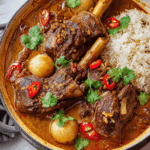
Lamb Shanks Massaman Curry
- Prep Time: 15 minutes
- Cook Time: 3 hours 15 minutes
- Total Time: 3 hours 30 minutes
- Yield: 4 servings 1x
- Category: Main Course
- Method: Oven braise
- Cuisine: Thai
- Diet: Halal
Description
Tender oven-braised lamb shanks simmered in a fragrant Thai massaman curry with coconut milk, potatoes, onion, star anise, and cinnamon, finished with fresh chili and coriander over jasmine rice.
Ingredients
- 1.5 kg / 3 lb lamb shanks, 5 small or 4 medium or 2 to 3 large
- 114 g / 4 oz Massaman curry paste, 1 can, Maesri preferred
- 400 ml / 14 oz full fat coconut milk
- 2 cups low sodium chicken stock or broth
- 1 onion, halved then sliced 1 cm thick
- 400 g / 14 oz small potatoes, about 2.5 cm wide, halve if larger
- 1 whole star anise
- 1 cinnamon stick
- Garnishes: finely sliced red chili, fresh coriander or cilantro
- Steamed jasmine rice, for serving
Instructions
- Preheat the oven to 180°C or 350°F, 160°C fan.
- In a 22 x 33 cm or 9 x 13 inch glass or ceramic baking dish, whisk the curry paste with coconut milk and the chicken stock until evenly combined.
- Add the sliced onion, the potatoes, the star anise, the cinnamon stick, and nestle the lamb shanks into the sauce, turning to coat all sides.
- Cover the dish tightly with foil and bake for 2 hours to gently braise until the meat begins to soften.
- Remove the foil and continue baking for 1 hour for small shanks or 1.5 hours for medium to large shanks, turning the meat twice so it browns evenly. Cook until the meat is so tender it can be teased apart with two forks.
- Transfer the shanks to a plate. Tilt the baking dish and skim off excess fat from the surface, about one third cup. Stir the sauce and simmer in the hot dish briefly if needed until it reduces to a glossy, syrupy consistency.
- Serve the shanks over steamed jasmine rice. Spoon over plenty of sauce and garnish with sliced red chili and coriander. For sharing, arrange on a platter and serve family style.
Notes
- Note 1: Shank size affects timing. Small shanks finish faster, large or meaty shanks may need the full uncovered time.
- Note 2: Maesri brand paste gives balanced flavor. Other Thai brands work, but salt and heat can vary, so taste and adjust.
- Note 3: Use full fat coconut milk for body and silkiness. Skim surface fat after cooking to keep the sauce balanced.
- Note 4: Choose low sodium stock to avoid an overly salty sauce as it reduces.
- Note 5: A glass or ceramic baking dish helps maintain gentle, even heat for braising.
- Note 6: The sauce should reduce until it lightly coats the back of a spoon. If too thin, return to the oven uncovered for a few minutes.
- Turn shanks during the uncovered stage to promote even browning and color.
- For a lighter bowl, serve with extra steamed vegetables and a modest scoop of rice.
Nutrition
- Serving Size: 1 lamb shank with sauce
- Calories: 620
- Sugar: 5 g
- Sodium: 750 mg
- Fat: 35 g
- Saturated Fat: 22 g
- Unsaturated Fat: 12 g
- Trans Fat: 0 g
- Carbohydrates: 30 g
- Fiber: 3 g
- Protein: 40 g
- Cholesterol: 120 mg
Keywords: Lamb Shanks Massaman Curry, lamb shanks massaman curry recipe, slow cooker lamb shank massaman curry, lamb massaman curry BBC Good Food, best lamb shank curry recipe, lamb shanks massaman curry coconut milk, lamb massaman curry slow cooker, authentic lamb massaman curry recipe


